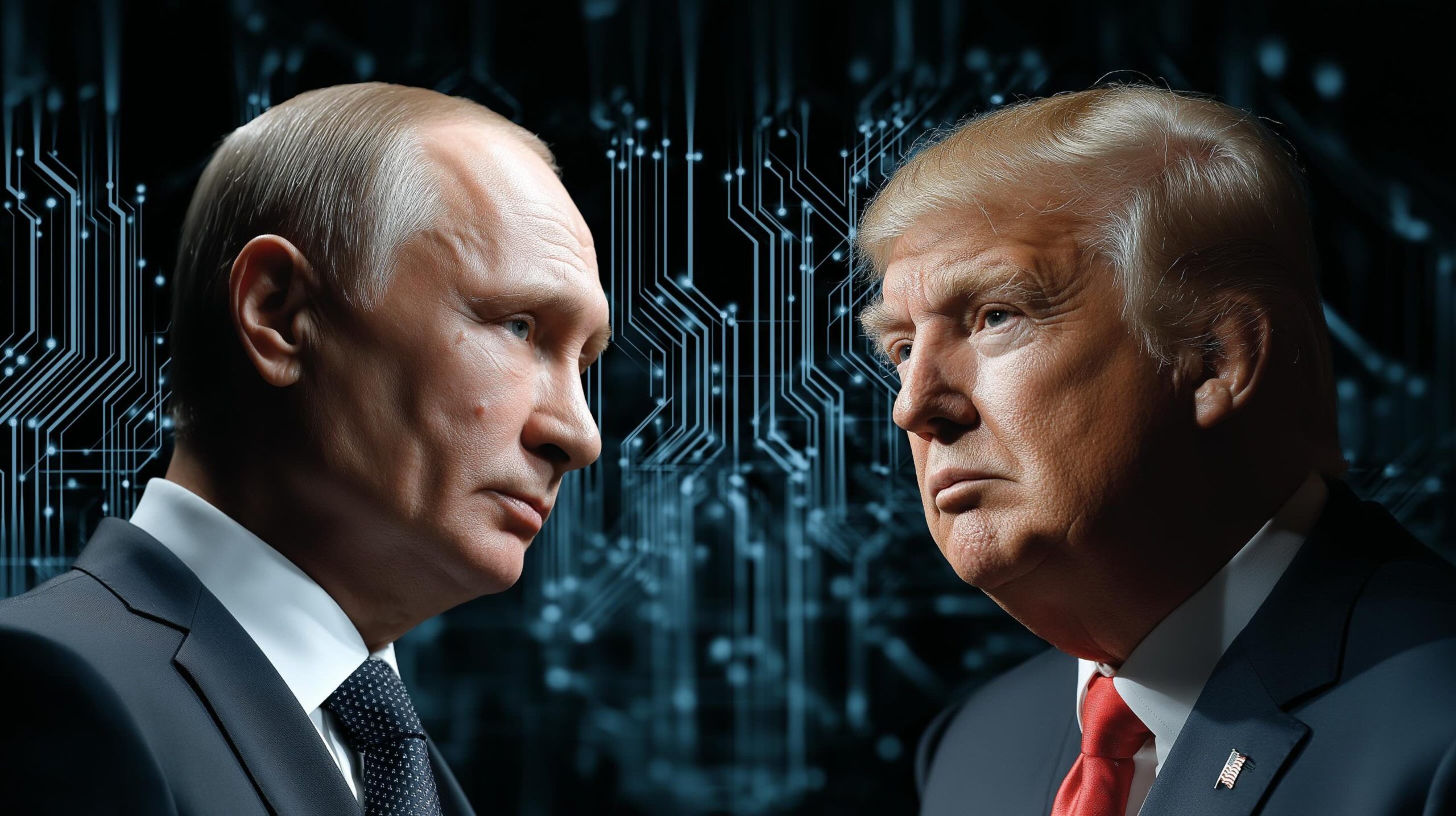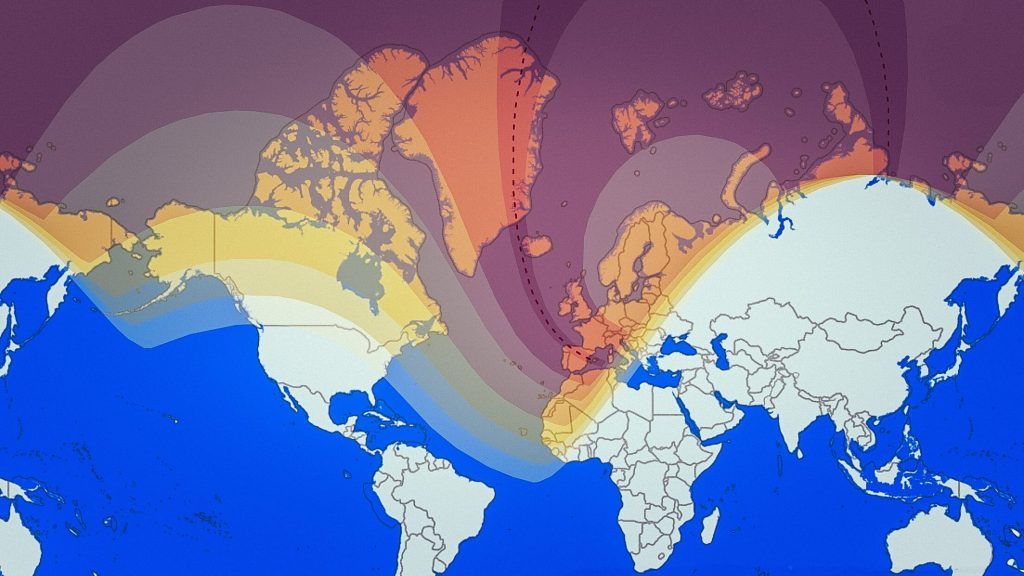- The Anchorage talks occurred in mid-August 2025 in Alaska between Donald Trump and Vladimir Putin, aimed primarily at ending the war in Ukraine.
- No public cyber accords were announced at the summit, signaling tacit accommodation on cyber issues.
- In March 2025, a senior U.S. cyber diplomat omitted Russia from a list of major state cyber threats, signaling a softening stance.
- New START is due to expire in February 2026, and Putin indicated openness to a new arms-control accord that Trump reportedly wants.
- Verification for a New START successor would likely rely on data exchanges, on-site inspections, and national technical means such as satellites.
- A GAO review notes verification tools would range from baseline measures like portal sensors and satellite imaging to more intrusive radiation detectors, with some technologies 5–10 years from deployment.
- Russia’s nuclear-powered icebreaker Yakutia, a 33,500-ton vessel launched in 2022, figures into discussions about Arctic cooperation and LNG infrastructure.
- Russia operates more than 50 icebreakers, several nuclear-powered, while the U.S. has two polar-capable icebreakers and none are nuclear-powered.
- The Arctic Satellite Broadband Mission (ASBM) launched in 2024 as a U.S.-Norwegian project, using highly elliptical orbits and carrying the EPS-R payload to deliver secure, anti-jam communications for Arctic-deployed forces.
- Semiconductors and export controls remained a central lever, with Russia’s import of semiconductors and electronics rebounding to pre-war levels by 2023–24 via a network of third-country brokers and shell companies.
In mid-August 2025, U.S. President Donald Trump and Russian President Vladimir Putin met in Anchorage, Alaska, for high-stakes talks primarily aimed at ending the war in Ukraine [1] [2]. While the focus was on ceasefire negotiations, a range of technology-related issues loomed over the summit – both in official discussions and in the broader strategic context. These included cybersecurity concerns, nuclear arms control frameworks, Arctic infrastructure and communications, critical mineral supply chains, and warfighting technologies (drones, satellites, semiconductors). This report examines each of these dimensions, drawing on recent news and expert commentary.
Cybersecurity and Cyber Operations
Ever since Russia’s interference in the 2016 U.S. election, cybersecurity has been a fraught topic in U.S.-Russia relations. Notably, at Trump’s 2018 Helsinki meeting with Putin, Trump appeared to accept Putin’s denial of election meddling over U.S. intelligence conclusions [3]. In the run-up to Anchorage 2025, there was concern about whether Trump would address issues like election interference, critical infrastructure hacking, or “red lines” in cyberspace. However, early signals from the Trump administration suggested a softening of stance on Russian cyber threats. In March 2025, a senior U.S. cyber diplomat pointedly omitted Russia from a list of major state cyber threats (naming only China and Iran) [4] [5], a stark departure from previous U.S. assessments. This was echoed by internal directives reportedly telling U.S. cybersecurity agencies (like CISA) to stop prioritizing Russian threat monitoring [6] [7]. Critics warn that ignoring Russia’s aggressive cyber activities – from ransomware gangs to infrastructure intrusions – is “delusional” [8]. By effectively taking “Putin off the hook” in cyberspace, the U.S. risks inviting more Russian cyber operations absent any mutual norms or explicit agreements. Unlike the 2021 Biden-Putin summit (where critical infrastructure was declared off-limits), the Anchorage meeting produced no public cyber accords. Instead, the ambiance is one of tacit accommodation: a sharp contrast to years of U.S. policy. As one expert put it, “Putin is on the inside now,” describing the sense that Moscow no longer feels contained by fear of U.S. cyber retaliation [9]. Going forward, the lack of clear cyber “red lines” or joint norms raises the stakes – especially with U.S. elections on the horizon and both nations possessing formidable cyber arsenals.
Nuclear Arms Control and Verification Technologies
A subtler but critical topic hovering over the summit was the future of nuclear arms control. The last major U.S.-Russia arms treaty (New START) is due to expire in February 2026 [10], and Putin hinted he was open to a new accord – something “he knows Trump wants” [11]. Indeed, Trump has expressed interest in a grand deal that could cap or reduce nuclear arsenals (potentially seeking a legacy as a peacemaker). Any such framework would rely heavily on verification technology. U.S. officials anticipate that verifying a New START successor would use similar measures as New START – data exchanges, on-site inspections, and national technical means like satellites [12] [13]. Space-based surveillance is especially vital: modern reconnaissance satellites can track missile deployments and test launches, providing early warning of treaty violations. Sensors and monitoring tools are evolving as well. The U.S. National Nuclear Security Administration has outlined tiers of verification tech – from “baseline” tools proven under New START (e.g. portal sensors, satellite imaging) to more intrusive technologies like radiation detectors to confirm warhead dismantlement [14]. Such advanced measures (e.g. devices that read the radioactive signature of a weapon) could bolster trust but are still 5–10 years from deployment [15]. A major challenge for any new treaty is encompassing novel systems. Russia has been developing exotic delivery vehicles (hypersonic glide vehicles, nuclear-powered cruise missiles, etc.), which a future accord would need to address. Verifying these may require innovative approaches – for example, space-based infrared sensors to detect missile launches outside the traditional ICBM paradigm. Satellite imagery and radar will play a key role in monitoring compliance, but they have limits. As a GAO review noted, smaller weapons (like tactical nuclear warheads) are hard to track via satellite, and distinguishing nuclear vs. conventional dual-use missiles by imagery alone is difficult [16]. In Anchorage, Putin’s offer of talks on “global strategic security” [17] signals that arms control is back on the table. The technological backdrop – from verification tools to missile defense – will heavily influence these negotiations. (It hasn’t gone unnoticed that Trump’s own push for a multi-layer “Golden Dome” missile defense system, including space-based interceptors, worries Russia [18] [19], since expansive U.S. missile defenses could undermine deterrence and complicate arms control efforts.)
Arctic Technology Infrastructure and Icebreakers
One concrete proposal circulating at the summit was unexpected: U.S. use of Russian nuclear icebreakers to assist in American Arctic projects. Alaska’s vast liquefied natural gas (LNG) initiative – which involves an 800-mile pipeline to bring North Slope gas to an export terminal – could benefit from extended seasonal navigation. Russia operates the world’s only fleet of nuclear-powered icebreakers, enabling year-round Arctic shipping along the Northern Sea Route [20]. According to Reuters sources, White House officials internally discussed striking a deal for Russian icebreaker vessels to support Alaska’s LNG development [21] [22]. The idea would be to leverage Russia’s advanced icebreaking tech to keep Alaskan waters open longer for energy shipments. This reflects a U.S. capability gap: currently, the U.S. has only two polar-capable icebreakers (none nuclear-powered), versus Russia’s fleet of over 50 icebreakers (several of them nuclear) [23] [24]. Russian nuclear icebreakers like the 33,500-ton Yakutia (launched in 2022) can plow through 3-meter-thick ice and are central to Moscow’s Arctic ambitions [25] [26]. Trump appeared intrigued by joint economic projects in the Far North, seeing them as “wins” if the Ukraine war can be settled [27] [28]. Putin, for his part, brought a delegation of Russian business figures to Alaska, signaling interest in such deals – though Trump emphasized “they’re not doing business until we get the war settled” [29].
Launch ceremony of the Russian nuclear-powered icebreaker Yakutia in St. Petersburg (Nov 22, 2022). The U.S. has privately weighed hiring Russia’s unique icebreakers to assist with Alaska’s LNG export project [30] [31].
The prospect of U.S.-Russian cooperation on icebreakers has drawn scrutiny. Alaska officials noted that, so far, the developers of the Alaska LNG project have “no identified needs” for Russian icebreakers and haven’t formally requested them [32]. Former Lt. Gov. Mead Treadwell suggested that if allowed, the project could use icebreakers from any nation – underscoring that U.S. policy would have to permit Russian involvement first [33]. Beyond LNG, technological dependencies in the Arctic are a strategic consideration. Russia’s icebreakers not only help commerce but also could ferry heavy equipment to remote Arctic sites [34] – an enticing capability for infrastructure-poor Alaska. However, relying on Russian assets raises security flags: these ships’ presence in Alaska would symbolize a major Russian role in North American Arctic affairs, something U.S. hawks would resist. Indeed, Putin has long prioritized the Arctic; under his rule, Russia built out ports, reopened Soviet-era bases, and launched new Arktika-class icebreakers, aiming to “strengthen Russia’s status as a great Arctic power” [35] [36]. Arctic analysts note it would take the West at least a decade to catch up to Russia’s Arctic military infrastructure if it tried [37]. All this suggests that tech cooperation in the Arctic – whether on icebreakers, energy, or climate monitoring – is intertwined with geopolitical competition. The Anchorage summit hinted at a possible thaw in Arctic economic ties [38] [39], but any deal on icebreakers would require navigating these strategic undercurrents.
Satellite Communications and ISR in the Arctic
Modern military strategy in the Arctic depends heavily on satellite communications and surveillance (ISR – intelligence, surveillance, reconnaissance). The polar regions pose unique challenges: above ~65°N latitude, traditional geostationary satellites (hovering over the equator) have poor coverage due to the Earth’s curvature [40]. This has left high latitudes with patchy connectivity and big ISR blind spots [41]. Both the U.S. and Russia recognize that as Arctic activity increases – from shipping to submarine patrols – robust comms and monitoring are critical. In fact, the Pentagon’s 2024 Arctic Strategy explicitly calls for investing in space-based capabilities to enhance Arctic communications, environmental sensing, and all-domain awareness [42] [43]. One breakthrough has been the launch of the Arctic Satellite Broadband Mission (ASBM) in 2024, a U.S.-Norwegian partnership. The ASBM satellites fly in highly-elliptical orbits to provide continuous coverage over the High North [44] [45]. Each satellite carries military and commercial payloads – including a U.S. Space Force package (EPS-R) that delivers secure, anti-jam communications for Arctic-deployed forces [46]. Notably, this is the first time a U.S. military communications payload has been hosted on a commercial satellite platform [47]. Such hybrid approaches greatly cut costs and demonstrate how allied tech can fill gaps. The result is improved bandwidth for troops, sensors, and even unmanned systems in polar areas. Northrop Grumman, which built ASBM, noted that Arctic ISR was previously limited by lack of comms – for example, long-endurance drones couldn’t be fully utilized because they couldn’t relay data reliably [48]. With new satellites and LEO constellations, that is changing. The U.S. has also tested commercial low-earth-orbit networks like OneWeb and SpaceX’s Starlink in the Arctic. In 2022, NORTHCOM Commander Gen. Glen VanHerck oversaw trials of Starlink and OneWeb terminals in Alaska, seeking to “provide command and control…from a tactical level in the Arctic all the way to the strategic level” [49] [50]. These LEO satellites orbit closer to Earth and cover polar regions well, offering high-data-rate links. By integrating such commercial satcom into military systems, the Pentagon aims to enable secure communications for Arctic forces and seamless data-sharing with allies [51]. Enhanced connectivity also boosts domain awareness: for instance, it can support real-time sharing of radar or sonar tracking data across the Arctic, improving early warning of incursions. At the Anchorage summit, Arctic security was reportedly on the agenda [52] [53]. The U.S. Department of Defense has recommended expanding space-enabled ISR to mitigate risk as both Russia and NATO increase operations up north [54] [55]. In practice, that means more polar-orbit satellites, better encrypted communications, and deployment of high-altitude surveillance drones optimized for extreme latitudes. Commercial technology is a big part of this equation, as seen with Starlink’s rapid deployment. In summary, the Arctic is getting “wired” – by a mix of government and private satellites – to close the High North communications gap. This will be pivotal in managing Arctic incidents and preventing miscalculations as great-power competition extends into the thawing polar seas.
Rare Earth Minerals and Critical Supply Chains
In a surprise twist, rare earth minerals became a bargaining chip in the Trump-Putin dialogue. Just days before the summit, leaks suggested Trump was prepared to offer Putin access to rare earth deposits – both in Alaska and in parts of Ukraine – as an incentive for peace [56] [57]. Rare earth elements (like neodymium, dysprosium, etc.) are crucial for high-tech industries – they go into everything from smartphones and electric vehicles to missile guidance systems. The U.S. and its allies currently depend heavily on imports (especially from China) for these materials. Trump has “made no secret” of his interest in securing resource deals around the world [58]. Under his administration, the U.S. even inked a minerals memorandum with Ukraine, eyeing Ukraine’s considerable mineral reserves [59]. Now, facing Russia across the table, Trump appeared willing to dangle Alaska’s untapped rare earths as a carrot. This overture did not go unnoticed: a senior Russian lawmaker mused that Russian firms “could be interested” in working on Alaska’s rare earth deposits [60]. (“Chukotka is nearby, our lands are nearby,” he quipped – referring to the Russian region just across the Bering Strait from Alaska.) From Moscow’s perspective, U.S. offers to share mineral opportunities signaled a weakening of Western resolve to isolate Russia [61] [62]. Indeed, Putin has encouraged the U.S. to cooperate on rare earth projects since early 2025 [63]. He knows America’s tech sector is hungry for non-Chinese sources of critical materials. As one Russian press commentary noted, U.S. manufacturers can’t get enough rare-earth metals for microelectronics and defense, and Trump himself has repeatedly pointed out Russia’s richness in resources [64].
However, any suggestion of giving Putin a “money-making chance” in Alaska or Ukraine has met fierce political resistance in the U.S. [65] [66]. Republican Senator Dan Sullivan of Alaska publicly warned that Alaska’s rare earth mineral resources must not be used as a bargaining chip in any Ukraine peace deal [67]. Many in Congress fear such a concession would reward Putin economically and potentially give Russia leverage over strategic supply chains. There’s also the historical symbolism: Russian nationalists have long regretted selling Alaska to the U.S. in 1867 [68], and Russia recently even declared that sale “illegal” (purely rhetorically) [69]. Talk of opening Alaska’s resources to Russia thus struck a nerve domestically. Nevertheless, Trump did not rule it out when pressed by reporters – saying “We’ll see what happens” regarding mineral incentives for Putin [70]. In parallel, rumors swirled that the peace package might allow Russia to retain control of rare earth-rich areas in occupied eastern Ukraine. For example, eastern Ukraine (Donbas) has sizable deposits of lithium and rare earths; a peace that freezes lines could de facto give Moscow access to those. Ukrainian officials are alarmed at any deal trading away resource sovereignty.
From a global perspective, the tech industry has a stake in how this plays out. If the war ends with cooperation on critical minerals, it could reshape supply chains – possibly integrating Russian production with Western tech companies (a scenario many thought impossible after 2022). On the other hand, continued conflict or a Cold Peace will keep Russia largely cut off from Western tech trade, and the U.S. will accelerate development of domestic or allied rare earth mining (for instance, projects in Australia or Canada) to reduce dependence. It’s telling that resource scarcity is a common thread in both the U.S.-Russia and U.S.-China equations [71]. The halt in the U.S.-China trade war earlier in 2025 was also linked to rare earths – China’s dominance made decoupling risky for U.S. industry [72]. Thus, rare earth minerals sit at the nexus of geopolitics and technology. The Anchorage summit, oddly enough, put a spotlight on that fact: peace in Ukraine might be bought not just with words and security guarantees, but with rocks and metals critical to 21st-century economies. Washington will have to weigh the long-term implications of any such arrangement very carefully.
War-Related Technology Dynamics (Drones, Satellites, Semiconductors)
The Russia–Ukraine war has been defined by rapid technological improvisation on both sides. As the Anchorage talks sought to halt the fighting, underlying tech issues – from drones to satellite internet to supply of microchips – remained highly relevant.
Uncrewed Aerial Vehicles (UAVs) have played a dominant role in the conflict. Russia and Ukraine each launch dozens of drones daily for reconnaissance and strikes. In fact, during recent intense fighting, Russian forces claimed to shoot down up to 270 Ukrainian drones in just 24 hours [73] [74]. From inexpensive quadcopters dropping grenades to Iran-supplied Shahed kamikaze drones, these systems have changed battlefield lethality. Any ceasefire will have to address monitoring or limiting drone activity, lest autonomous or remotely piloted strikes spark new escalation. There’s talk of “drone control” zones or jamming arrangements as part of a settlement. Putin has publicly highlighted Ukraine’s use of drones to attack Russian cities and infrastructure (often framing it as Western-enabled aggression) [75]. Meanwhile, Ukraine has used long-range drones to hit airbases deep in Russia. Both sides exploiting UAVs – and the difficulty in fully stopping them – means this technology will cast a long shadow even if large-scale ground fighting stops. U.S. and NATO officials are surely considering how to curb the flow of drone components to Russia (many Russian drones contain Western electronics) and how to support Ukraine’s counter-drone defenses long-term.
Satellite internet has been a double-edged sword in the war. SpaceX’s Starlink constellation became a lifeline for Ukraine’s military communications after Russia destroyed or jammed other networks. Starlink’s thousands of LEO satellites allowed frontline units and drone operators to stay connected even when cell towers were down. However, the outsized influence of this private tech was laid bare when Elon Musk unilaterally intervened. In September 2022, as Ukraine mounted a major counteroffensive, Musk ordered Starlink service shut off over certain liberated areas, reportedly to prevent a Ukrainian drone attack on Russian forces [76] [77]. This sudden blackout caused Ukrainian drones to lose link and artillery units to go offline, nearly derailing an operation [78] [79]. Recent Reuters investigations confirm that Musk’s action “shocked” Starlink employees and Ukrainian officials, and effectively allowed one billionaire to influence battlefield outcomes [80] [81]. While Musk insists SpaceX won’t disable communications again, the episode raises big questions. For one, Russia has tried to jam or hack Starlink signals, but with limited success – highlighting how resilient the system is and how reliant Ukraine has become on it. For another, it underscores that control of strategic tech (like global satellite networks) might need to be addressed in conflict resolution. There were rumors that Russia, as part of any peace, would demand restrictions on Western ISR and comms support to Ukraine – essentially curbing things like Starlink that give Ukraine an edge. Conversely, Western planners see systems like Starlink as crucial for deterrence, not just in Ukraine but in any future flashpoints. The Pentagon is now contracting multiple commercial satellite providers to ensure no single company can make or break military comms. The war thus heralds a new paradigm: commercial space tech as a strategic asset – and potential bargaining piece.
Finally, semiconductors and export controls remain a linchpin issue. From the war’s start, the U.S. and EU imposed strict bans on exporting high-tech components to Russia, aiming to cripple its war machine. Advanced chips are needed for guided missiles, secure radios, drones, and tanks. Initially, these sanctions seemed to bite: Russia had to curtail some precision weapon use and was seen harvesting chips from dishwashers and refrigerators to fill the gap [82]. But as the conflict ground on, Russia’s tech supply chains adapted. By 2023–24, analysts noted that Russia’s import of semiconductors and electronics rebounded to pre-war levels [83]. Moscow accomplished this via a vast network of third-party brokers and shell companies in third countries (e.g. China, Turkey, the UAE) to procure Western chips despite the embargo [84] [85]. Many of the components found in captured Russian weapons are actually common commercial-grade chips – the same as those in consumer appliances [86]. Because these are “omni-use” technologies present in countless products, outright blocking them is exceedingly difficult [87]. Russian engineers have shown ingenuity in repurposing such low-end chips for military use, even if that means adding cooling systems or accepting shorter lifespans for electronics [88]. A U.S. Senate report in 2023 flagged that U.S.-made chips from companies like Texas Instruments and Analog Devices were turning up in Russian missiles, likely via illicit circuits in East Asia and the Caucasus. The Biden administration tightened controls further, but stopping the dual-use loophole remains challenging.
All this matters because if a peace deal emerges, enforcement of technology sanctions will be a key leverage point. The West may offer to relax certain export controls if Russia genuinely disengages (for instance, allowing some civilian high-tech trade to resume). Conversely, if Russia continues aggression by other means, the U.S. will push for even tougher “chokehold” measures on semiconductors – possibly pressuring countries like China not to supply Russia with advanced chips (so far, China has mostly refrained from sending cutting-edge semiconductors, but it provides plenty of older-model chips). The outcome of the war will shape global semiconductor flows: a stable truce might see Russia pivot to sourcing more chips legally for reconstruction and industry, whereas a frozen conflict would keep it reliant on black markets and clandestine imports to sustain its military. The tech decoupling between Russia and the West, practically total in the defense sector now, could potentially be eased by a diplomatic accord – but only in a verifiable way. Western officials insist that Russia’s capacity to rebuild its military must be constrained; that means long-term monitoring of components going into Russia. Newfangled methods like AI-driven trade analysis and blockchain tracking of chips are being tested to spot diversion of electronics to Russia [89]. In essence, the war has spotlighted the critical importance of supply chains for semiconductors – and how export controls can slow an adversary’s advances, but also how determined actors can circumvent them.
Conclusion: Technology permeated every facet of the Trump-Putin Anchorage summit. While headlines focused on territorial concessions and ceasefire terms, the subtext included cyber warfare norms unspoken, satellite paths overhead, minerals underfoot, and circuits in missiles. The meeting demonstrated that modern great-power diplomacy is inseparable from tech competition and cooperation. Any durable peace or modus vivendi will require reckoning with these tech dimensions: establishing guardrails for cyber and space, leveraging Arctic assets responsibly, securing critical materials, and managing the proliferation of warfighting tech. The Anchorage summit may or may not produce a peace in Ukraine – as of its conclusion, a concrete ceasefire was still elusive – but it has undoubtedly framed the technological chessboard on which future U.S.-Russia relations will play out. Both Washington and Moscow will be digesting the lessons of this encounter: that bits, atoms, and bytes are as crucial as bullets and bombs in shaping global security in 2025 and beyond.
Sources: Recent reporting and analysis were drawn from Reuters [90] [91], Al Jazeera, TASS (Russian news agency) press reviews [92] [93], the Council on Foreign Relations [94], Breaking Defense [95] [96], FedScoop [97] [98], Politifact [99], the Guardian [100] [101], the Daily Beast [102] [103], and the Carnegie Endowment [104] [105], among others. These provide a comprehensive, up-to-date view of the technological angles of the Trump-Putin meeting and its broader context.
References
1. www.reuters.com, 2. www.reuters.com, 3. abcnews.go.com, 4. www.theguardian.com, 5. www.theguardian.com, 6. www.theguardian.com, 7. www.theguardian.com, 8. www.theguardian.com, 9. www.theguardian.com, 10. www.reuters.com, 11. www.reuters.com, 12. www.gao.gov, 13. www.gao.gov, 14. www.gao.gov, 15. www.gao.gov, 16. www.gao.gov, 17. tass.com, 18. tass.com, 19. tass.com, 20. www.reuters.com, 21. www.reuters.com, 22. www.reuters.com, 23. tass.com, 24. tass.com, 25. www.reuters.com, 26. www.reuters.com, 27. www.reuters.com, 28. www.reuters.com, 29. www.reuters.com, 30. www.reuters.com, 31. www.reuters.com, 32. www.reuters.com, 33. www.reuters.com, 34. www.reuters.com, 35. www.reuters.com, 36. www.reuters.com, 37. www.reuters.com, 38. tass.com, 39. tass.com, 40. breakingdefense.com, 41. breakingdefense.com, 42. media.defense.gov, 43. media.defense.gov, 44. breakingdefense.com, 45. breakingdefense.com, 46. breakingdefense.com, 47. breakingdefense.com, 48. breakingdefense.com, 49. fedscoop.com, 50. fedscoop.com, 51. fedscoop.com, 52. tass.com, 53. tass.com, 54. media.defense.gov, 55. media.defense.gov, 56. www.thedailybeast.com, 57. www.thedailybeast.com, 58. tass.com, 59. tass.com, 60. tass.com, 61. tass.com, 62. tass.com, 63. tass.com, 64. tass.com, 65. www.thedailybeast.com, 66. www.thedailybeast.com, 67. www.alaskasnewssource.com, 68. www.thedailybeast.com, 69. www.thedailybeast.com, 70. www.thedailybeast.com, 71. tass.com, 72. tass.com, 73. tass.com, 74. tass.com, 75. tass.com, 76. www.reuters.com, 77. www.reuters.com, 78. www.reuters.com, 79. www.reuters.com, 80. www.reuters.com, 81. www.reuters.com, 82. carnegieendowment.org, 83. carnegieendowment.org, 84. carnegieendowment.org, 85. carnegieendowment.org, 86. carnegieendowment.org, 87. carnegieendowment.org, 88. carnegieendowment.org, 89. carnegieendowment.org, 90. www.reuters.com, 91. www.reuters.com, 92. tass.com, 93. tass.com, 94. tass.com, 95. breakingdefense.com, 96. breakingdefense.com, 97. fedscoop.com, 98. fedscoop.com, 99. abcnews.go.com, 100. www.theguardian.com, 101. www.theguardian.com, 102. www.thedailybeast.com, 103. www.thedailybeast.com, 104. carnegieendowment.org, 105. carnegieendowment.org










